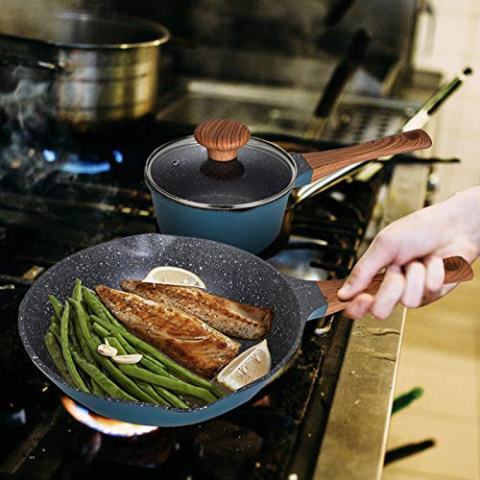Stoneware cookware is becoming more common since people are opting for healthier cooking choices. If you want to change to healthier cooking, stoneware products are the best choice. There has been an increase in the risk of consuming toxic substances like lead metal, arsenic, and cadmium through cookware. For this reason, people are shifting to stoneware cookware that is safer than other types of cookware.
However, to achieve your goal, it is important to understand the types of stoneware cookware. In addition, you should know how to use each type to prevent any toxins from getting into your food. Stoneware cookware is safe and easy to clean. It is also lightweight with added strength making them more durable than metal cookware.
What Is Stoneware or Stone Cookware?
Stone cookware is cookware made from stone-containing material. Cookware coated with stone-derived material is also a type of stoneware. The cookware is durable and free from any toxins. Stones are insulators making stoneware to have poor-heating properties.
This property makes pure stoneware to be excellent for baking rather than cooking. The coated stoneware contains other materials that increase heat conductivity making cooking easier and faster.

Stone Cookware Types
There are several types of stone cookware depending on the material used during manufacturing. These include:
1. Non-stick Stoneware:
It is the most popular stoneware in the market, also referred to as stone-line cookware. It contains PFOA or PTFE coatings. Perfluorooctanoic acid (PFOA) is a carcinogenic toxin that belongs to the PFAS family. It is unsafe since it contains toxins.
Teflon is a hydrocarbon-based polymer. It is safe and unreactive at low temperatures. When temperatures reach about 590 degrees F, it starts to produce harmful fumes. The fumes cause flu-like symptoms to pets, humans. The fumes are lethal to birds.
2. Porcelain-coated Or Granite Cookware:
This stoneware is made from kaolinite clay, a traditional material used in art and pottery. It is very durable and non-porous. However, it is very brittle with poor heating properties compared to other metal cookware. It is best for coffee pots, roasting, and canning pots. It is easy to clean and makes the cookware very attractive. It is safe, as it contains no toxic substances.
3. Non-stick Ceramic Cookware:
There are two types of non-stick ceramic coatings namely, Greblon and Thermolon. The coating comes from clay or sand making them safe and free from dangerous compounds. Manufacturers use the Sol-gel process to apply these ceramic coating to pans and pots. The traditional method for manufacturing ceramic cookware is safer than the present sol-gel process that contains titanium nanoparticles.
4. Pure Stoneware:
These include xtrema and stone bakeware. It is the safest stone cookware since it lacks toxic substances and other harmful metals. However, this type has poor heating properties. It is only best for baking and uses on the stove.
5. Enamel-coated Cookware:
It is a type of stoneware made from powdered-melted glass. It is very brittle and can crack easily under extreme heating. It is very safe with no toxins. It is also very stable.
Is Stoneware Cookware Safe?
The safety of stone cookware depends on the manufacturer. Finely crushed stones are added to nonstick cookware to increase heat conductivity and to add strength. Many people think that all stone cookware is safe and healthy with no toxic chemicals or harmful metals like lead.
However, some brands may contain few PTFE and other chemicals since these chemicals like arsenic, lead, and cadmium occurs in the soil naturally. These chemicals are present in too tiny amounts that cannot raise a concern. The high heating process that happens during manufacturing neutralizes the effects of the present chemicals.
It is therefore wise to contact the manufacturer to ensure that the brand you purchase is toxin-free. You can also read the fine print to see whether the manufacturer has used PTFE during coatings. Makers can toss terms like ceramic, enamel, or glass interchangeably to mean something different or the same thing. The nonstick stoneware may contain ceramic and PTFE and be safe only if used correctly.
What Are Stone Cookware Dangers?
Stone cookware more so the ones manufactured in the United States, is very safe to use. The cookware is free from cadmium, lead, and arsenic that brings health issues if consumed. However, some stone cookware may contain tiny amounts of these substances since they occur naturally in the soil.
The heating process that occurs while manufacturing stoneware cookware neutralizes the metal elements producing a safe item. Therefore, your food will be free from any toxic substances. Purchase a reputable brand that you are sure of being safe.
Is Stoneware Safer Than Metal Cookware?
Answer: Both stoneware and metal cookware are safe only if they are of high quality. However, stoneware cookware has the advantage of preventing food burning as it spreads heat evenly.
Second, quality stoneware is free from toxic substances and other harmful metals like lead, unlike other metal cookware.
Third, when cooking with stoneware, food does not react with the material, unlike copper that leaches into food bringing unhealthy issues. Some metal cookware reacts with some food releasing some harmful chemicals. All these advantages make stoneware to be safer than metal cookware. Both metal and stoneware cookware are safe if you use them properly.
Frequently Asked Questions - FAQs
Q. What is stoneware-cookware made of?
Answer: Stone cookware is a broad name for ceramics or pottery fired under very high temperatures. The product is made from non-refractory or stoneware fire clay to make a vitreous or semi-vitreous ceramic ware. Stone cookware processes under fire at a temperature between 2,010 degrees F and 2,370 degrees F.
Q. Is stoneware non-toxic?
Answer: High-quality stone cookware is non-toxic and safe. It is free from harmful substances like lead and cadmium. Pure stoneware does not react with any food to release any dangerous chemicals. When purchasing a set of stoneware cookware, ensure you select the best quality brand. Quality brands tend to be expensive. However, they are worth your money. You will enjoy healthy, non-toxic food throughout your life.
Q. Is stone-coated cookware safe
Answer: 100% stone-coated cookware is the safest item in the market. There are no toxins in the products that are associated with other non-stick and metal cookware. However, you should be very keen on the type of coating in the stone cookware since some brands contain PTFE and PFOA that is unsafe for your health. To maintain the stone-coated cookware, use wooden utensils while cooking. Also, use medium-high heating to avoid ruining the coating and use a soft sponge to clean. These tips will help to maintain the cookware for safe cooking.
Q. Is stoneware better than Teflon?
Answer: Stoneware is better than Teflon provided the stoneware is of high quality. Some Teflon brands still use PFOA resulting in Teflon posing a health threat to users. If you heat Teflon cookware above 500 degrees F, it releases fumes that can pose severe threats if inhaled for long.
Conclusion
There are so many believes associated with stoneware cookware that makes the topic huge. With the above information, you can now purchase any stoneware without safety worries. All you need to do is understand the types of stoneware cookware, their pros, and cons so you can choose the best.
In conclusion, stoneware cookware is the best cookware in the market provided you select the best quality package. It will serve you for eternity as you enjoy your safe meal free from toxins. Ensure you follow the instructions given by the manufacturer to maintain the cookware in good condition.
Related Reviews You May Read:

Hello, This is Annie Walker, a 38-year-old blogger, founder, and editor of Cookware Guider from NY, USA. I am a cookware fanatic and passionate cooker. I love to cook with different types of cooking appliances (example: all types of cookware, rice cookers, slow cookers, etc) almost every day in my kitchen. I love to share my experience with my readers in my blog. Also, I enjoy helping people to solve their problems through my website. You can follow me on Twitter & Pinterest. To know details about my blog please check the about us page.
